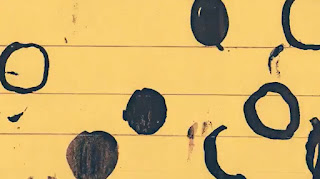Documentation (Icon)
To begin documenting my object for the 'Icon' element of the brief I wanted to take a simple idea and execute it really well. Without thinking too much about the ideas and justifications behind a process or outcome at the start, it is easier to make work that focuses on the quality of the visual outcome.
I made a simple set up in a dark corridor corner using two sheets of A3 paper and masking tape. I then took two safety pins and bent them out of shape as much as I could without hurting myself, as the Icon should be a documentation of the object, however I did not want to capture it in it's natural form.
Once I had my set up and objects ready, I began photographing them. My aim was to achieve a nice reflection from the metal by shining my torch on the abstract shapes - explaining why the set up was in a dark corner. The reflection is visible in some of my photos were the pins are out of focus, however, the nice effect that I achieved focused more on the shadows. I realised that the out of shape pins created a reflective shadow when the torch was shone on them - and this created some interesting outcomes.
I also took some scans with my phone of the set-up. These outcomes were a lot more contrasting as the aim of the scan is usually to eliminate shadows. I preferred the images with a lot more dark space in them as I think these look a lot more dramatic and somehow more emotional.
Upon reflection I think that this way of working could be manipulated to justify the solar eclipse research. The use of shadow and light and dark is really interesting within this work as their is such a strong contrast paired with soft gradients. It could be nice to take forward in conjunction with this theme.
Abstraction and Interpretation (Index)
Creating outcomes for Index was very different to Icon. The process was more haphazard, trial and error etc. but this was appropriate for the 'abstraction' theme. To actively achieve this abstraction the process I focused on was using the scanner. By simply throwing safety pins onto the scanner and messing around with zoom, crop, and invert, I quickly had many different variations and manipulations of my object.
I experimented with just the object at first, trying to abstract it as much as I could by blowing it across the scanner and focusing on specific parts of the pin, cropping others out. I then naturally began to incorporate other elements, like using scrunched up tinfoil as a background. Seen as it had the same qualities visually as a safety pin I thought that it would create interesting outcomes - and it injected a lot of contrast and interesting marks into the scans.
I finally then began to play around with the photographs that I had previously taken. As these were a lot more refined, the outcomes are naturally less grainy and textured as the others. I think these outcomes have a different feel to them even though they have been through the same processes - which is interesting to reflect on. The abstracted images of the already modified pins are really intriguing and almost sinister - they have a puppet on a string like quality to them that can't quite be 'pinned' down.
This technique clearly pairs very well with the punk theme throughout my research. I think to develop it further it could be interesting to convey the emotion of 'pain' (e.i. from the pin prick of a safety pin). I could take this really literally and photograph or illustrate a pin pricked finger or more conspicuously, perhaps making 'blood' splatters with ink.
Image Comparison (Symbol)
The index was really abstracted, however 'Symbol' took it to a new level. I introduced elements from my research by collaging them with my own outcomes that I had made so far. When looking at my research I decided to pick out punk flyers, imagery of protests, and X-ray scans.
I really enjoyed pushing the scanner to it's limits of what could achieve: as I decided to go full on and abstract them as much as I could. I started by creating simple collages that took imagery from my own work, and my research in the form of simple shapes. I then put these through the scanner and printed them on some charcoal texture I found. I find that running a collage through the scanner and adding some rough texture helps pull it all together.
This was abstract, but I wanted to push it further and so began inverting my collages and then collaging them back onto the original, so it created really harsh contrast. I like the relationship between the harsh, dense, contrast and the gradient shadow that comes from my photographs.
I think that now that I have done the most extreme that I can, I can take a step back and achieve the level of abstraction that is appropriate. I can now say to myself 'this is too abstract' or. 'not abstract enough' because I know how far the imagery can be pushed.
When I look at these finalised collages, for whatever reason, I see stomachs. I can't explain why but i think that the combination f textures and shapes simply remind me of a torso. I can visualise using this technique to take forward the 'injection of safety pins' research along with possibly including X-ray imagery.
Possible Further Research
Psycho shower scene
X-ray imagery
Man Ray's Iron




















































